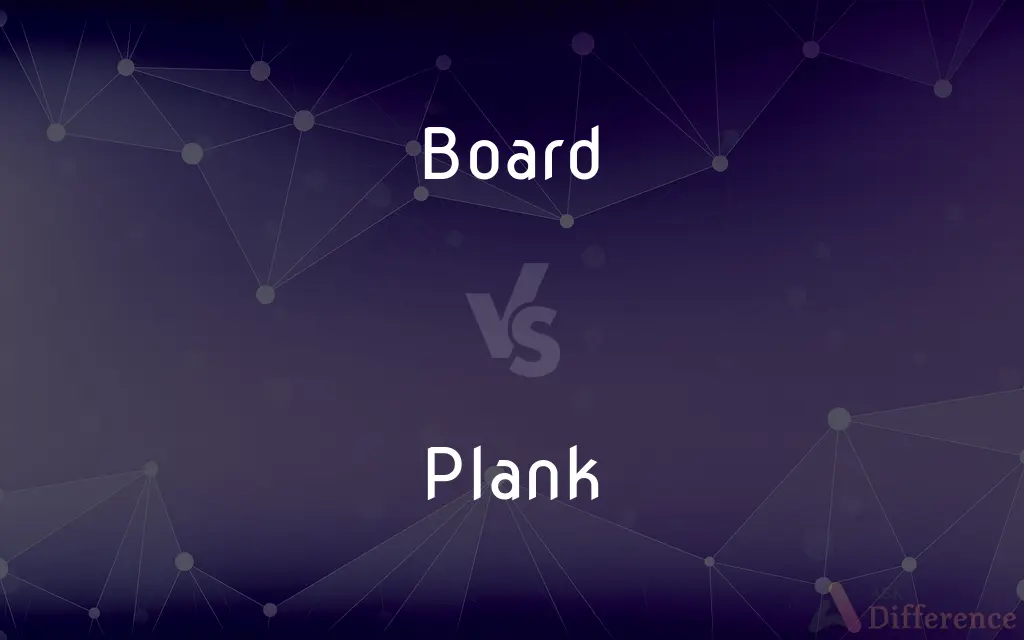Board vs. Plank — What's the Difference?
By Fiza Rafique & Maham Liaqat — Updated on March 5, 2024
A board is a thin, flat, and rectangular piece of wood used for construction and crafting, while a plank is thicker, used for strength in floors and decks.

Difference Between Board and Plank
Table of Contents
ADVERTISEMENT
Key Differences
A board is typically used in a variety of construction and crafting projects due to its versatility and availability in various thicknesses and sizes. It is often employed in the fabrication of furniture, paneling, and shelving, offering a smooth surface ideal for painting and finishing. On the other hand, a plank is specifically thicker and used where strength and durability are required, such as in the construction of floors, decks, and outdoor structures. Its greater thickness makes it suitable for supporting weight and withstanding environmental elements.
Boards are generally available in standard widths and thicknesses, making them a go-to choice for interior construction projects, such as cabinetry and trim work. They are easily workable and can be cut, nailed, or screwed with basic tools. Planks, whereas, are chosen for their structural integrity in heavier construction projects. Their width and thickness can vary, but they are consistently thicker than boards, providing the necessary support for heavy loads and high traffic areas.
Boards can offer a finer grain, making them more suitable for projects where appearance is important, such as furniture making or interior detailing. While planks, on the other hand, may have a more rustic appearance, making them a popular choice for outdoor projects or where a more robust, natural look is desired.
The choice between board and plank also depends on the specific requirements of a project, including durability, appearance, and load-bearing capacity. Boards are often preferred for projects requiring a smooth finish and precise measurements, whereas planks are chosen for their strength and durability, especially in outdoor or structural applications.
Despite their differences, both boards and planks play crucial roles in construction and woodworking. Choosing between them involves considering the specific needs of the project, such as the desired aesthetic, the structure's function, and environmental exposure.
ADVERTISEMENT
Comparison Chart
Thickness
Thinner, varying less in size
Thicker, providing more strength
Use
Construction, crafting, furniture
Floors, decks, structural support
Appearance
Smoother, finer grain
Rustic, more natural look
Durability
Varies, often used indoors
High, suitable for outdoor use
Load-bearing
Less suited for heavy loads
Ideal for high traffic and weight
Compare with Definitions
Board
A piece used in board games.
She moved her piece across the board to win the game.
Plank
Strengthens structures.
The bridge's durability comes from the heavy wooden planks.
Board
A flat surface for writing or displaying.
She wrote the menu on the chalkboard.
Plank
Used in flooring for its durability.
The hardwood planks were chosen for the new floors.
Board
Material for shelves or paneling.
We chose a high-quality board for the kitchen cabinets.
Plank
Part of outdoor construction.
Planks were used for the fence in the backyard.
Board
Used in crafts and DIY projects.
He used colorful boards to make the wall art.
Plank
A thick, long piece of wood for structural projects.
They laid planks down to build the deck.
Board
A thin piece of wood used for construction.
The carpenter cut the board to size for the bookshelf.
Plank
Aesthetic choice for a rustic look.
The dining room featured a beautiful, plank-built table.
Board
A long flat slab of sawed lumber; a plank.
Plank
A piece of lumber cut thicker than a board.
Board
A long flat slab of another material, used as a structural member.
Plank
Such pieces of lumber considered as a group; planking.
Board
A flat, rigid, often rectangular piece of material used as a surface upon which to work
A cutting board.
An ironing board.
Plank
A foundation; a support.
Board
A flat piece of material designed or equipped to be ridden as a sport, especially a snowboard, skateboard, or surfboard.
Plank
Set (something or oneself) down with or as if with a noise;
He planked the money on the table
He planked himself into the sofa
Board
A flat, rigid piece of material on which a game is played, such as a checkerboard or chessboard.
Board
A board on which information can be displayed to public view
Board
A flat portable surface (usually rectangular) designed for board games;
He got out the board and set up the pieces
Board
Food or meals in general;
She sets a fine table
Room and board
Common Curiosities
What makes a plank different from a board?
Planks are thicker than boards and are often used for structural support in flooring, decks, and outdoor constructions due to their strength.
Can boards be used for flooring?
While boards can technically be used for flooring, planks are generally preferred for their thickness and durability.
Is there a specific thickness that differentiates a board from a plank?
There's no strict rule, but planks are typically thicker than ¾ inch (19 mm), a common threshold where boards end and planks begin.
What is a board used for?
Boards are used for a wide range of construction and crafting projects, including furniture making, shelving, and paneling.
Are planks more expensive than boards?
Due to their thickness and the type of wood used, planks can be more expensive than boards, especially if chosen for aesthetic qualities.
Can I use a plank for furniture making?
Yes, planks can be used for making sturdy and rustic-looking furniture, though boards are often preferred for finer pieces.
What type of wood is best for planks?
Durable woods like cedar, redwood, and pressure-treated options are ideal for planks used in outdoor or structural applications.
Are all boards made of wood?
While traditional boards are wood, there are also boards made from composite materials, such as MDF or particleboard.
Do planks require special tools for working?
Due to their thickness, working with planks might require more powerful tools for cutting and shaping compared to boards.
Can boards be used outdoors?
Boards can be used outdoors if properly treated or made from weather-resistant wood, though planks are often better suited for outdoor conditions.
How do I choose between a board and a plank for my project?
Consider the project's requirements for strength, appearance, and exposure to elements. Planks are better for structural or outdoor projects, while boards are suitable for detailed or indoor work.
Are there environmental considerations when choosing between boards and planks?
Yes, consider the source of the wood and opt for sustainably harvested options to minimize environmental impact.
Can planks be finished in the same way as boards?
Yes, planks can be sanded, stained, and finished similarly to boards, though the final look will differ due to the wood's characteristics.
How do maintenance requirements differ between boards and planks?
Planks, especially in outdoor settings, may require more maintenance like sealing or staining to protect against the elements, compared to indoor boards.
Can the terms "board" and "plank" be used interchangeably?
While they can sometimes be used interchangeably in casual conversation, they refer to pieces of wood of differing thicknesses and are chosen based on the specific needs of a project.
Share Your Discovery

Previous Comparison
Logic vs. Logical
Next Comparison
Seminarian vs. SeminaristAuthor Spotlight
Written by
Fiza RafiqueFiza Rafique is a skilled content writer at AskDifference.com, where she meticulously refines and enhances written pieces. Drawing from her vast editorial expertise, Fiza ensures clarity, accuracy, and precision in every article. Passionate about language, she continually seeks to elevate the quality of content for readers worldwide.
Co-written by
Maham Liaqat














































